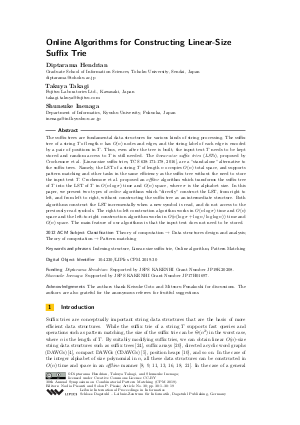@InProceedings{hendrian_et_al:LIPIcs.CPM.2019.30,
author = {Hendrian, Diptarama and Takagi, Takuya and Inenaga, Shunsuke},
title = {{Online Algorithms for Constructing Linear-Size Suffix Trie}},
booktitle = {30th Annual Symposium on Combinatorial Pattern Matching (CPM 2019)},
pages = {30:1--30:19},
series = {Leibniz International Proceedings in Informatics (LIPIcs)},
ISBN = {978-3-95977-103-0},
ISSN = {1868-8969},
year = {2019},
volume = {128},
editor = {Pisanti, Nadia and P. Pissis, Solon},
publisher = {Schloss Dagstuhl -- Leibniz-Zentrum f{\"u}r Informatik},
address = {Dagstuhl, Germany},
URL = {https://drops-dev.dagstuhl.de/entities/document/10.4230/LIPIcs.CPM.2019.30},
URN = {urn:nbn:de:0030-drops-105016},
doi = {10.4230/LIPIcs.CPM.2019.30},
annote = {Keywords: Indexing structure, Linear-size suffix trie, Online algorithm, Pattern Matching}
}

 Creative Commons Attribution 3.0 Unported license
Creative Commons Attribution 3.0 Unported license
